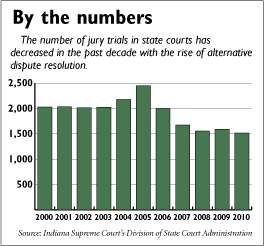Subscriber Benefit
As a subscriber you can listen to articles at work, in the car, or while you work out. Subscribe NowFewer jury trials during the past decade have created concern that young lawyers are losing the ability to gain real-world litigation experience, leading more lawyers to turn to law schools and internal firm training to get what has been a fixture in the practice of law.
State courts have seen the number of trials drop by more than 500 between the years 2000 and 2010, which attorneys attribute to an increased use of mediation. Court statistics released by the state judiciary’s administrative division show that 1,514 jury trials occurred last year; in 2005, there were 2,450 jury trials.
 Herzog
Herzog“Litigation still drives our system,” said Valparaiso University Law School professor David Vandercoy, who teaches skills training and heads up the school’s legal clinic. “We’re moving forward on the thought that even with a decline in jury trials, our system is still adversarial in nature, and so lawyers need to be equipped to handle these litigation issues even if they can’t get the experience from actually being in court.”
At Valparaiso, Vandercoy said half of the third-year law class does firm externships to help provide that experience.
“Most of our students see that litigation training as something that makes them more marketable,” he said. “They need these skills whether they’re litigating or not.”
Law firms agree about the importance of litigation exposure. Many have mentoring programs for associates or send younger attorneys to litigation training programs. Some have mock courtrooms – Faegre Baker Daniels has one in its Minnesota office.
Faegre Baker Daniels partner David Herzog, a longtime litigator at the trial and appellate level, said his firm sends third-year litigation associates to the National Institute for Trial Advocacy to learn those skills.
“It’s getting harder and harder to get that experience, and while NITA is a great resource, there’s no substitute for real-life trial experience,” he said. “You aren’t ever going to see an end to litigation and jury trials because sometimes reasonable people disagree, and the only way to resolve a dispute is to go to court.”
Herzog, like many lawyers, attributes the decline in litigation experience to the increase in alternative dispute resolution. He said attorneys used to be responsible to maneuver mediation during the course of litigation, but now that role has been largely transferred to neutral mediators. Herzog thinks the decrease in jury trials has actually had a negative impact on attorney-to-attorney mediation.
“The saying used to be that you settle cases on the courthouse steps … because that’s when the sense of real urgency and pertinent risk sets in,” Herzog said. “Having that trial experience makes you appreciate the risks of litigation and gives you credibility with opposing counsel when trying to settle a case. If you’ve never tried a case, and you sit across the table trying to get a specific number, that lack of experience is a credible threat to your bottom line.”
 Indianapolis attorney Kara Kapke with Barnes & Thornburg, who’s been with the firm since 2005, tries to weave courtroom-specific aspects of a case into all of her litigation tasks. For example, when she’s doing a deposition or planning for motion writing, she often asks herself what might happen in court and how she would respond.
Indianapolis attorney Kara Kapke with Barnes & Thornburg, who’s been with the firm since 2005, tries to weave courtroom-specific aspects of a case into all of her litigation tasks. For example, when she’s doing a deposition or planning for motion writing, she often asks herself what might happen in court and how she would respond.
“Even if you’re not on your feet in court, you’re at least keeping your mind fresh about what litigation might throw at you and how you can handle that,” she said.
Her colleague, partner Scott Murray, said that the firm pairs younger attorneys with seasoned litigators, sends associates to training and also puts them on the front lines of arbitration where they can get experience that’s similar to what they might face in a courtroom. He recalled how a team of associates divided its handling of questions, motions and other aspects of arbitration against a lead partner at a New York law firm.
“You have to get that experience where you can, and these days it’s tougher to find those opportunities,” he said.
 Bruess
BruessRetired attorney Charles Bruess in Brownsburg – who practiced law 30 years at Barnes & Thornburg before becoming a courtroom deputy for U.S. Judge David Hamilton in the Southern District of Indiana – has been working for the past three years to help teach what he describes as “the lost art of litigation” to the legal community. He wrote the book “What You Didn’t Learn in Law School about Trial Practice,” in 2007, and since then, he’s been teaching continuing legal education and consulting with attorneys on litigation practices he observed during his career.
Bruess is working with the Indiana State Bar Association to possibly offer free CLE on the topic of litigation, and he hopes that more of the legal community is willing to embrace the CLE to learn the litigation lessons that come from first-hand experience.
Lawyers who have attended Bruess’ sessions have told him that they took his lessons with them into practice. These can be simple tasks such as knowing to look up a judge’s local rules before stepping into court and being prepared for objections to not be recorded if the lawyer is not standing up, Bruess said.
“I get a lot of personal satisfaction from that, bumping into people who say they’ve asked themselves a question at a deposition or thought about something before going into court,” he said. “These things may never happen to you as a practicing lawyer, but at least you’ll know they are possible in litigation and you can be ready.”•
Please enable JavaScript to view this content.
